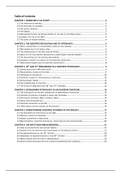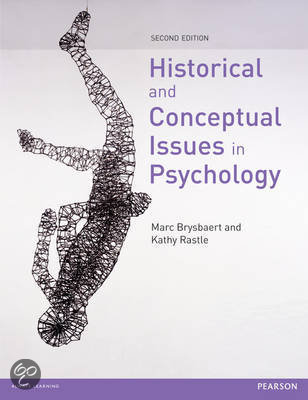Table of Contents
CHAPTER 1: WHERE DID IT ALL START?..............................................................................................2
1.1 THE INVENTION OF WRITING................................................................................................................2
1.2 THE DISCOVERY OF NUMBERS..............................................................................................................2
1.3 THE FERTILE CRESCENT.......................................................................................................................2
1.4 THE GREEKS.....................................................................................................................................2
1.5 DEVELOPMENTS FROM THE ROMAN EMPIRE TO THE END OF THE MIDDLE AGES............................................3
1.6 TURNING THE TIDE IN THE WEST..........................................................................................................4
1.7 THE LIMITS OF HISTORY WRITING..........................................................................................................4
CHAPTER 2: THE SCIENTIFIC REVOLUTION AND ITS AFTERMATH.......................................................5
2.1 FROM A GEOCENTRIC TO A HELIOCENTRIC MODEL OF THE UNIVERSE............................................................5
2.2 MECHANISATION OF THE WORLD VIEW..................................................................................................5
2.3 THE FORMULATION OF THE FIRST LAWS OF PHYSICS.................................................................................5
2.4 WHAT SET OFF THE SCIENTIFIC REVOLUTION IN SEVENTEENTH-CENTURY EUROPE?.........................................6
2.5 THE NEW METHOD OF THE NATURAL PHILOSOPHER..................................................................................6
2.6 CHANGES IN SOCIETY AS A RESULT OF THE SCIENTIFIC REVOLUTION.............................................................7
2.7 HOW REVOLUTIONARY WAS THE SCIENTIFIC REVOLUTION?........................................................................8
CHAPTER 3: 18TH AND 19TH PRECURSORS TO A SCIENTIFIC PSYCHOLOGY...........................................9
3.1 INDIVIDUALISATION IN WESTERN SOCIETY..............................................................................................9
3.2 PHILOSOPHICAL STUDIES OF THE MIND..................................................................................................9
3.3 TEXTBOOKS OF PSYCHOLOGY.............................................................................................................10
3.4 SCIENTIFIC STUDIES OF ‘PSYCHOLOGICAL’ FUNCTIONS.............................................................................10
3.5 EVOLUTIONARY THEORY....................................................................................................................11
3.6 THE CONTRIBUTION OF STATISTICS......................................................................................................12
3.7 THE STATUS OF MEDICINE IN THE 18TH AND 19TH CENTURIES....................................................................12
CHAPTER 4: ESTABLISHING PSYCHOLOGY AS AN ACADEMIC DISCIPLINE.........................................13
4.1 THE FOUNDATION OF THE FIRST LABORATORY OF EXPERIMENTAL PSYCHOLOGY............................................13
4.2 STARTING PSYCHOLOGY IN AMERICA: JAMES AND TITCHENER..................................................................13
4.3 PSYCHOLOGY IN FRANCE: RIBOT, CHARCOT, BINET................................................................................14
4.4 FREUD AND PSYCHOANALYSIS............................................................................................................15
4.5 STARTING PSYCHOLOGY IN THE UK.....................................................................................................15
4.6 WHAT ABOUT THE FIVE SCHOOLS OF PSYCHOLOGY?..............................................................................16
CHAPTER 5: STRENGTHENING SCIENTIFIC STANDING OF PSYCHOLOGY...........................................17
5.1 THE PERCEPTION OF PSYCHOLOGY IN THE USA.....................................................................................17
5.2 MAKING A SCIENCE OF BEHAVIOR.......................................................................................................17
5.3 ADDING COGNITIONS TO BEHAVIOUR..................................................................................................19
5.4 BEHAVIOURISMS, COGNITIVE PSYCHOLOGY, STRUCTURALISM AND FUNCTIONALISM......................................20
CHAPTER 6: THE INPUT FROM BRAIN RESEARCH.............................................................................21
6.1 IDEAS IN ANCIENT EGYPT AND ANCIENT GREECE....................................................................................21
6.2 INSIGHTS INTO THE ANATOMY AND FUNCTIONING OF THE NERVOUS SYSTEM...............................................21
6.3 THE BREAKTHROUGHS OF THE 19TH CENTURY........................................................................................22
6.4 EMERGENCE OF NEUROPSYCHOLOGY IN THE 20TH CENTURY.....................................................................23
6.5 BRAIN IMAGING AND THE TURN TO NEUROSCIENCE................................................................................23
6.6 INVESTIGATING DELUSIONS WITH THE COGNITIVE NEUROPSYCHIATRY APPROACH..........................................24
,Chapter 1: Where did it all start?
1.1 The invention of writing
The preliterate culture: Lindberg’s research revealed three important characteristics of knowledge in
civilisation before writing was invented:
- He observed that preliterate civilisations’ knowledge is confined to ‘know-how’ without
theoretical understanding of the underlying principles.
- Knowledge of the actual history of the tribe is limited to two generations and the function of
the oral tradition mainly is the transmission of practical skills.
- They believed objects and nature are inhabited by spirits with human-like characteristics,
which cause events to happen, which is called animism.
It is only when information is written down that patterns start to emerge and incompatibilities
become visible. Therefore, Lindberg argued, scientific thinking cannot occur without written records.
Written language: Written language appeared separately in at least four cultures (China, Egypt,
Sumer and America); in each case it was preceded by proto-writing.
Characteristics of writing: Writing consists of a combination of pictograms and phonograms.
- Pictogram: An information-conveying sign that consists of a picture resembling the person,
animal or object it represents.
- Phonogram: A sign that represents a sound or a syllable of spoken language; forms the basis
of writing systems.
External memory: Written records form an external memory, which allows an accumulation of
knowledge. New thinkers do not have to rediscover what was previously thought; they can simply
read what their predecessors wrote.
The reader: For a long time the number of readers was limited. They also were not encouraged to
think critically about what they were reading.
1.2 The discovery of numbers
Another development that has been crucial for the growth of knowledge is the discovery of numbers.
Knowledge depends on counting and measuring.
Beginning of numbers: The first written forms of counting consisted of lines in bones and stones.
Because it is difficult to discern more than four lines in a glance, the tallies were grouped. The
grouping usually occurred in fives. Gradually a separate symbol was used for five and multiples of
five. Later number systems were based on multiples of 10.
Limits of symbols: The Greek and Roman number systems were suboptimal because their notation
did not assign a meaning to the place of the digits. Such a place coding system was developed in
India. This required the invention of a symbol for 0.
1.3 The fertile crescent
The presence of written records marks the distinction between prehistory and history. The Sumerian
and Egyptian cultures were part of the so-called Fertile Crescent. This is a region south-east of the
Mediterranean Sea, which included Ancient Mesopotamia and Ancient Egypt.
Ancient Egypt: Two main contributions from the Egyptians were geometrical knowledge and the
devising of a calendar consisting of 12 months of 30 days and an extra 5 days at the end of the year.
Ancient Mesopotamia: Mathematical knowledge was more sophisticated in Mesopotamia. One of
the areas in which they applied their mathematical knowledge was astronomy, which they used for
their calendar and to determine the times for planting and harvesting.
1.4 The Greeks
Ancient Greece was probably the first culture that started to ask serious questions about the nature
of the world they lived in. This was the beginning of philosophy.
Plato: The first thinker to call philosophy a distinct approach with its own subject and method. He is
regarded as the one who coined the word ‘philosophy’, defined as ‘love of wisdom’.
, - The first important element of Plato’s philosophy was the distinction he made between the
realm of eternal, never-changing ideal forms and the realm of the everchanging material
reality in which the forms or ideas are imperfectly realised and which we perceive.
- Plato further considered the soul and the body as two distinct and radically different kinds of
entity, and he saw the soul as the entity defining the person.
- Three parts of the soul:
o Reason: Allowed humans to get access to the realm of the ideal forms. According to
Plato, reason was situated in the brain.
o Sensation and emotions: Dealt with anger, fear, pride and courage. It was mortal
and situated in the heart.
o Appetite and lower passions: Dealt with lust, greed and desire. It was localised in the
liver.
Aristotle: He was a student of Plato, but deviated in important ways from his mentor (e.g. he did not
postulate an independent realm of ideal forms).
- Three types of knowledge: Aristotle divided knowledge into three kinds;
o Productive knowledge was concerned with making things, such as farming,
engineering, art or rhetoric.
o Practical knowledge referred to how men ought to act in various circumstances,
both in private and public life (e.g. ethical and political knowledge).
o Theoretical knowledge was neither production nor action, but truth. It was further
subdivided into three classes: mathematics, natural science and theology.
- Theoretical knowledge starts with axioms: According to Aristotle, theoretical knowledge
consisted of a series of axioms from which the remaining knowledge was derived by means
of logic. Knowledge of the organisation of the universe and the propensities in it, together
with perceptual information, provided humans with the axioms.
- Logic: Because theoretical knowledge was derived from the axioms by means of logic, several
of Aristotle’s manuscripts dealt with how to test whether a statement is true or false.
Aristotle called elementary statements ‘propositions’. Propositions were combined into a
syllogism. This is an argument consisting of three propositions: the major premise, the minor
premise, and the conclusion.
- The role of observation: On the one hand, Aristotle attached much importance to careful
observation and documentation. On the other hand, Aristotle was equally clear that
observation alone was not enough for true knowledge. Perception was the source of
knowledge, but was not knowledge itself.
Foundation of schools: Plato and Aristotle also founded schools (respectively the Academy and the
Lyceum), which together with two other schools would educate students for centuries.
Shift to Alexandra: Under Alexander the Great, there was significant expansion and interaction with
other cultures, leading to what is called the Hellenistic culture and a shift to Alexandria, where
knowledge became more mathematical and specialised.
1.5 Developments from the Roman empire to the end of the Middle Ages
Ancient Romans: The Greek methods and learning were transferred to Rome, where there was
already quite a strong Greek presence. One major difference between the Romans and the Greeks
was that the Romans were much more interested in practical questions than the philosophical
debates that preoccupied the Greeks.
Byzantine Empire: Civil wars gave rise to a division between an East and a West Empire. Rome
remained the capital of the West Empire, but the heart of the civilisation shifted to the east, the
Hellenistic world, where the Byzantine Empire was founded. The main contribution of Byzantium to
the history of science seems to have been the preservation of the legacy of the Ancient Greeks.
Arab Empire: The Arabian peninsula had been untouched by Alexander’s military campaigns. As a
result, it was not much affected by Byzantine culture either. They founded on Islam and contained





